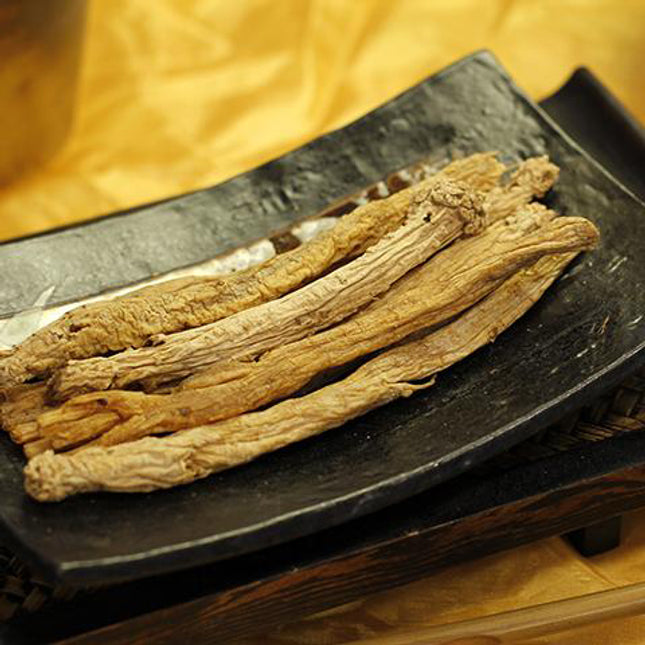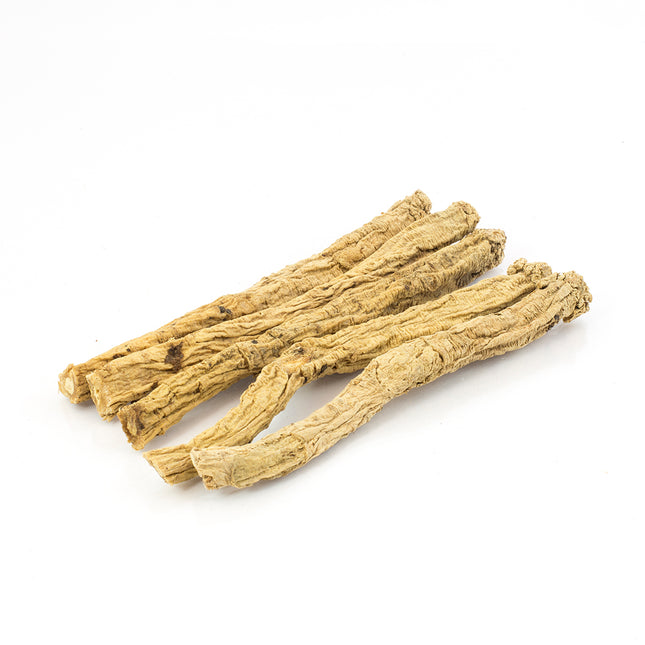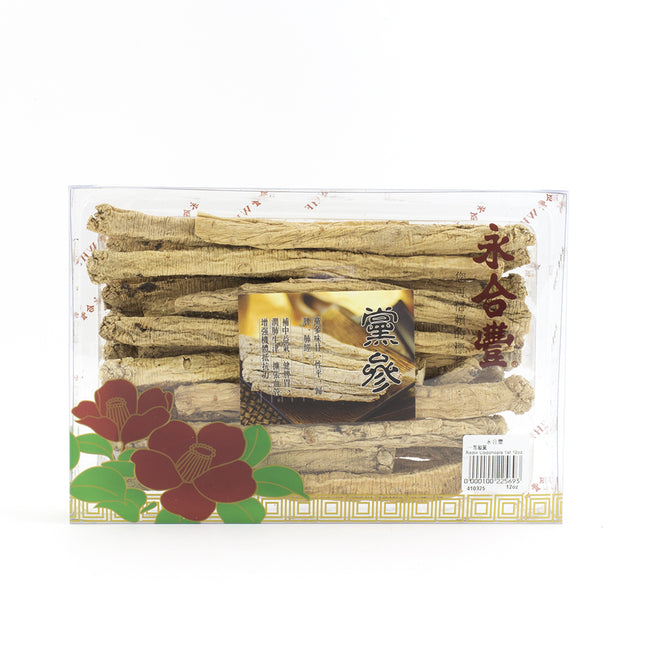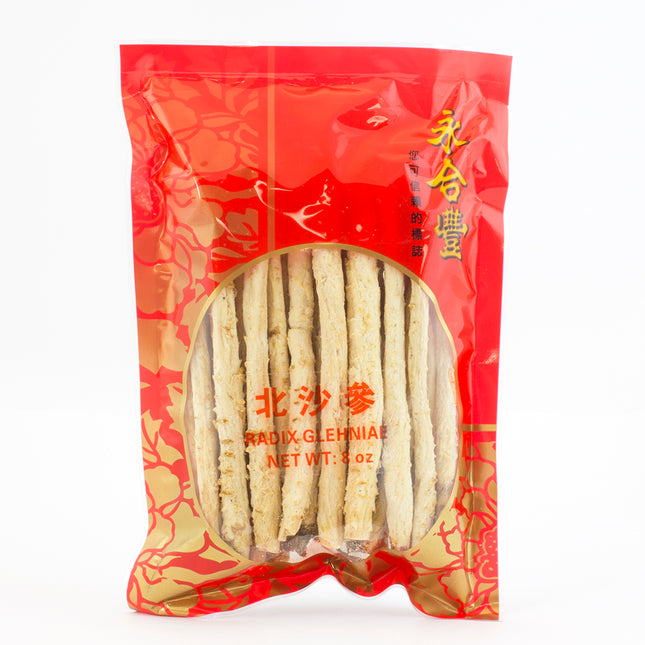特级原色 贡品 纹党参(8 oz)
尺寸
8-9支/8 oz
性味
甘,平。
功效
本品为桔梗科植物党参、素花党参(西党参)或川党参的干燥根。 主治脾胃虚弱,气血两亏,体倦无力,食少便溏,内热消渴,久泻,脱肛,肺虚喘咳,气短自汗,气微两亏诸证。
经脉
归脾经、肺经。
主治
补中,益气,生津,益肺。治脾胃虚弱,气血两亏,体倦无力,食少便溏,内热消渴,久泻,脱肛,肺虚喘咳,气短自汗,气微两亏诸证。
注意禁忌
有实邪者忌服。不宜与藜芦同用。
【食疗方】
1.玉竹党参粥
玉竹20g,党参30g,大米50g.先将玉竹、党参煎煮取汁,去渣后放入大米,再加适量水煮粥。每日服2次,趁热食用。
功效:益气养阴。主治气阴两虚之疲乏无力、自汗、心悸怔忡、胃纳不佳、口干、手足心热或盗汗、少寝多梦等症。感冒、腹胀纳呆者暂停用。
2.参米茶
党参30克,粟米100克。将党参、粟米分别淘洗干净,党参干燥后研碎,粟米炒熟,同置于砂锅内。加入清水1000毫升,浸渍1小时后,煎煮20分钟停火,沉淀后倒入保温瓶内,代茶饮用。
功效:补脾养胃,益气滋阴。主治脾胃虚弱、食欲不振、胃脘隐痛等。
3.归参炖母鸡
当归15克,党参15克,母鸡1只、葱、生姜、料酒、食盐各适量。将母鸡宰杀后,去毛和内脏,洗净,将当归、参放入鸡腹内,再将鸡放进砂锅,加入葱、生姜、料酒、食盐、清水各适量,再将砂锅置武火上烧沸,改用文火煨炖,直至鸡肉粑烂即成。食用时,可分餐吃肉,喝汤。
功效:补血壮体。适用于肝脾血虚之慢性肝炎和各种贫血。
4.参枣米饭
党参10克,糯米250克,白糖50克。将党参、大枣放在砂锅内,加水泡发后煎煮30分钟左右,捞出党参、大枣,药液备用。将糯米洗净,放在大瓷碗中,加水适量,蒸熟后,扣在盘中 ,将党参、大枣摆在糯米饭上,药液加白糖,煎成浓汁后浇在枣饭上即成。可作早餐食用。
功效:健脾益气。主治体虚气弱,乏力倦怠,心悸失眠,食欲不振,便溏浮肿等。
5.参芪首乌精
党参250克,黄芪250克,制何首乌200克,白糖500克。将党参、黄芪、制首乌洗净,用冷水浸透,加水适量煮沸,沸后改为文火,每半小时取一次药液,共煎3次;将3次煎液混合,去药渣,再继续用文火煎熬浓缩,到稠如膏时停火待。
6.参杞酒
党参15克,枸杞15克,米酒500毫升。将党参、枸杞子洗净,干燥后研为粗末,放入细口瓶内,加入米酒,密封瓶口,每日振摇1次,浸泡7天以上。每次服15毫升,早晚各服1次。
功效:益气补血、宁心安神。主治心脾两虚、心悸失眠、夜寐多梦、食欲不振、肢体倦怠等。
7.参芪汤
党参250克 黄芪250克 白糖500克。将党参、黄芪洗净,以冷水泡透,加水适量煎煮,每半小时取药液1次,共煎煮3次,然后合并药液。将合并的药液用文火煎熬至稠粘时停火,等浓缩液冷却后,加入白糖,使之吸净药液,混合均匀,再晒干,压碎,装入玻璃瓶。
服法:用沸水冲化后服用,每次10克,每日2次。
功效:补益肺脾之气。适用于气虚型心悸气短、食少便溏、脏器下垂、浮肿、气喘、头晕等症。
Premium Pilose Asiabell Root / Codonopsis /Dang Shen (8 oz)
“Codonopsis seems to stimulate the central nervous system. It also seems to promote weight gain and increase endurance, as well as increase red and white blood cell counts and promote blood circulation.” (rxlist.com, webMD.com)
“Codonopsis is an herb. People use the root to make medicine. Codonopsis is used to treat HIV infection and to protect cancer patients against side effects of radiation treatment.” (webMD.com)
From the manufacturer:
The taste is sweet and its nature is neutral [neither warming nor cooling] This product is the dried root of Codonopsis pilosa, Codonopsis pilosa (West Codonopsis), or Codonopsis radiata. Indications: Weakness of spleen and stomach, deficiency of both qi and blood, body fatigue, loss of appetite, loose stools, internal heat. It is used to reduce thirst, chronic diarrhea, prolapse of the anus, lung deficiency and cough, shortness of breath and spontaneous sweating, and micro-circulation deficiency.
It enters the Spleen and Lung meridians.
Indications: It nourishes the middle [digestive center], nourishes qi, body fluids, and nourishes lung. It is used to cure spleen and stomach weakness, qi and blood deficiency, body fatigue, poor appetite, loose stools, internal heat. It reduces thirst, chronic diarrhea, prolapse of the anus, lung deficiency and cough, shortness of breath and spontaneous sweating, and micro-qi deficiency.
Cautions: Since codonopsis “raises qi” for prolapsed organs, avoid use for people who are dizzy, violent, or have a fever. It is not suitable for use with Veratrum (false hellebore.)
Diet Therapy
Polygonatum, Codonopsis Porridge
Ingredients:
Polygonatum odoratum 20g, Codonopsis pilosula 30g, and rice 50g.
First, decoct Polygonatum odoratum (Solomon’s Seal) and Codonopsis pilosula to get the juice. After removing the residue, add the rice, and add some water to cook the porridge. Eat it 2 times a day while it is hot.
Efficacy: Replenishing Qi and Nourishing Yin. Indications of fatigue, weakness, spontaneous sweating, heart palpitations, poor appetite, dry mouth, hot hands, feet, and night sweats, insomnia, and excessive or troubled dreaming. Suspend the use of this recipe during colds, bloating, and anorexia.
Codonopsis Tea
Ingredients
Codonopsis 30 grams, 100 grams of Foxtail millet.
Wash the Codonopsis and Foxtail millet separately, grind the Codonopsis after drying, fry the Foxtail millet, and put them in a casserole. Add 1000 ml of water, soak for 1 hour, decoct for 20 minutes, stop the fire, pour it into a thermos after precipitation, and drink it instead of tea.
Efficacy: nourish the spleen and stomach, nourish qi and nourish yin. Indications: Weakness of the spleen and stomach, loss of appetite, and dull pain in the stomach.
Codonopsis Stewed Hen
Ingredients:
15 grams of Angelica (tang kuei) 15 grams of Codonopsis, 1 hen, green onions, ginger, cooking wine, and salt.
After the hen is slaughtered, all the internal organs are removed, washed, and the angelica and ginseng are put into the belly of the chicken, and then the chicken is put into the casserole, adding the appropriate amount of green onion, ginger, cooking wine, salt, and water, and then placing the casserole on the fire. Bring to a boil and simmer until the chicken is cooked then is ready for serve.
When eating, you can eat meat and soup in separate meals.
Efficacy: nourishing blood and strengthening the body. It is suitable for chronic hepatitis and various anemias of liver and spleen blood deficiency.
Codonopsis and jujube date rice
Ingredients:
10 grams of Codonopsis, 250 grams of glutinous rice, 50 grams of jujube date, and sugar.
Cook the Codonopsis and jujube for about 30 minutes, and set aside the liquid medicine for later use. Wash the glutinous rice, after steaming, add the Codonopsis and jujube pieces. Add cane sugar to the liquid medicinal solution and pour it on the jujube rice. Serve. Can be eaten for breakfast.
Efficacy: invigorating the spleen and qi. Indications for physical weakness, fatigue, fatigue, palpitations, insomnia, loss of appetite, loose stools, and edema.
Codonopsis, Astragalus and Polygonum Multiflorum
Ingredients:
250 grams of Codonopsis, 250 grams of Astragalus, 200 grams of Polygonum Multiflorum, 500 grams of sugar.
Wash Codonopsis, Astragalus, and Polygonum Multiflorum, soak in cold water, add water to a boil, change to simmer after boiling. Drink the liquid medicine every half an hour, and decoct 3 times; mix the 3 decoctions, remove the medicine residue, and then continue to simmer and condense, and stop cooking when it becomes thick as a cream. [Use this as a tonic extract]
Codonopsis Wine
Ingredients:
15 grams of Codonopsis, 15 grams of wolfberry (aka goji berry), 500 ml of rice wine. Wash Codonopsis and Chinese wolfberry fruits, dry them and grind them into coarse powder, put them in a narrow-necked bottle, add rice wine, seal the mouth of the bottle, shake once a day, and steep it for more than 7 days.
Take 15 ml each time, 1 time in the morning and evening. Efficacy: To replenish qi and blood, calm the mind and spirit. Indications: for deficiency of the heart and spleen, palpitations, insomnia, sleepless nights, loss of appetite, fatigue, etc.
Codonopsis and Astragalus Soup
Ingredients:
Codonopsis 250 grams, Astragalus 250 grams, 500 grams of sugar. Wash Codonopsis and Astragalus, soak thoroughly in cold water, add an appropriate amount of water to make a decoction.
Drink some of the liquid medicine once every half an hour. Make a decoction 3 times in total, and then combine the liquid medicine batches. Simmer the combined liquid medicine until it is thick and then stop cooking.
After the concentrated liquid has cooled, add sugar to absorb the liquid medicine, mix it evenly, dry, crush, and put it into a glass bottle.
Dosage: Dissolve with boiling water and take it, 10 grams each time, 2 times a day.
Efficacy: For replenishing the Qi of the lungs and spleen. It is suitable for symptoms such as qi deficiency, heart palpitations, shortness of breath, poor appetite, loose stools, organ prolapse, edema, wheezing, and dizziness.
Read more less


 Boost your health and mental power with thousands of years old herbalism tradition
Boost your health and mental power with thousands of years old herbalism tradition 

















